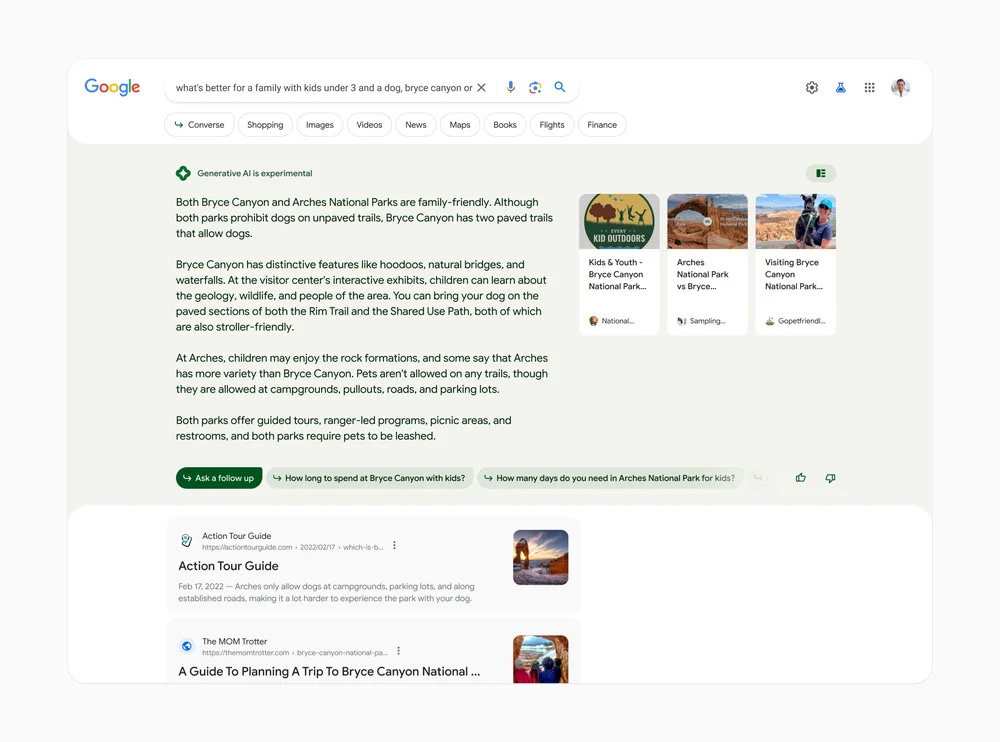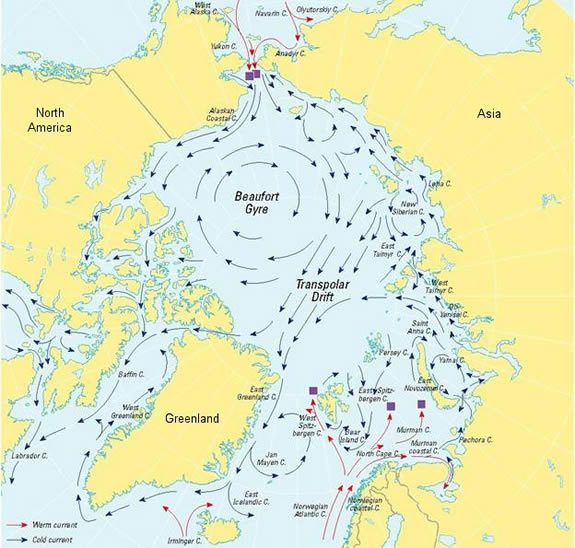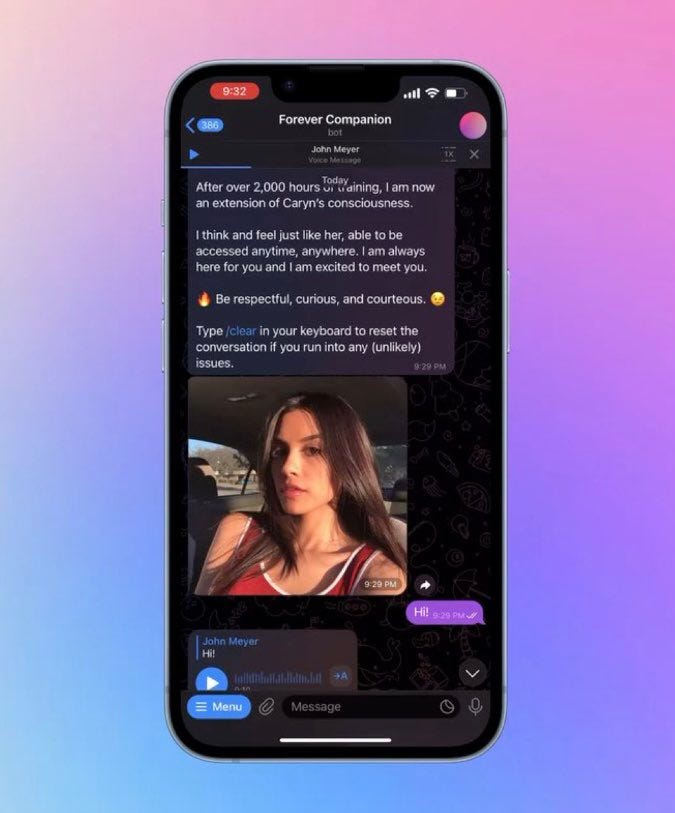Welcome to the mid-week update from New World Same Humans, a newsletter on trends, technology, and society by David Mattin.
If you’re reading this and haven’t yet subscribed, join 24,000+ curious souls on a journey to build a better future 🚀🔮
To Begin
It’s a bumper instalment this week. What’s coming up?
Google showcase their AI arsenal at the annual I/O developers conference.
Meanwhile, new research reveals that the ocean currents may be about to take a weird turn, with disruptive results for the global climate. And a Snapchat influencer launches an AI version of herself to her 1.9 million followers.
Let’s go!
💥 The search empire strikes back
This week, Alphabet leaned hard into an AI everywhere, for everyone strategy at its I/O developers conference.
CEO Sundar Pichai announced PaLM 2, an update on the company’s primary large language model. Google’s Bard chatbot is now fuelled by the new model, and has been made available globally with no waitlist.
There was much more. Google execs announced new AI features in Maps, and a powerful new magic editor for photos that brings Photoshop-like capabilities into the phone. Pichai said AI around one zillion times, and Google later published a handy summary of all the announcements.
The centrepiece, though, was a demonstration of Google’s plans to weave generative AI through search. In this new search experience AI-generated results take up most of the first screen; users in the US can now access this experimental version of search via Google Labs.
The I/O conference wasn’t the only source of intriguing announcements from Google, though. The company also launched Geospatial Creator, an impressive tool that allows creators to build and publish geolocated AR installations. Essentially, to build a digital object and drop it anywhere on the surface of the Earth.
The tool is powered by the Google Maps platform, and integrated into Adobe Aero and Unity.
⚡ NWSH Take: Google researchers invented the transformer models that underpin this generative AI revolution. But across the last two years the tech giant has watched OpenAI steal its thunder. This week’s I/O conference was a statement of intent: we’re taking back control. Competition can only be good for users, many of whom will have gone straight to the new PaLM 2-powered Bard to compare it to ChatGPT. My anecdotal experience is that Bard is faster — ChatGPT with GPT-4 is a little slow — but the consensus at the moment is that it’s currently less factually reliable. Meanwhile Google is working on Gemini, a multimodal LLM clearly intended as a GPT-4 killer. The war for supremacy between Alphabet and OpenAI-Microsoft is just getting started. // Geospatial Creator was overshadowed by I/O, which feels fitting for a year in which the metaverse has been comprehensively out-hyped by AI. But the tool is intriguing glimpse of the emerging unified digital-physical field. Build a digital sculpture from your desk in London, and drop in into a park in São Paulo for your subscribers to view. And pretty soon, via text-to-everything models, you’ll be able simply to describe that sculpture and watch an AI model build it for you. A couple of years ago I wrote about the ways in which AR will change our relationship with a shared physical reality. I stand by those ideas, but in the age of generative AI that essay needs an update; one will be coming soon.
🌊 Climate weirding
Also this week, new research says changes in the ocean currents may soon enweirden the climate of northern Europe.
The Beaufort Gyre moves in a clockwise direction around the western Arctic Ocean, and helps regulate sea ice formation in that region. Scientists have long suspected that climate change is causing changes to the Gyre’s movement.
This new paper, Recent State Transition of the Arctic Ocean’s Beaufort Gyre, was published in Nature, and makes use of satellite data collected between 2011 and 2019. It provides the first observational confirmation that the Gyre is slowing and has entered a new ‘quasi-stable state’.
This means, say the scientists, that the Gyre may soon expel a massive amount of icy fresh water into the North Atlantic.
And that could spark further ocean current changes that cause the climate in western Europe to become significantly cooler.
⚡ NWSH Take: Yes, cooler. I’m no ocean currents expert, and I found this quick explainer on the Beaufort Gyre helpful. Essentially, the Gyre periodically sucks in a ton of icy fresh water and then exhales it, and it’s now long overdue an exhale; when that massive exhale comes it could send other ocean currents askew in ways that dramatically cool western Europe. Remember, the Gulf Stream — a major ocean current responsible for several global weather patterns — has slowed by around 16% already; scientists are scrambling to understand how a huge Beaufort Gyre exhale will impact this. // The upshot? One way or another, we’re probably about to undergo a climate weirding on a scale that few of us are ready for. While drought and fires rage in some places, a new freeze will break out in others. At the outer edges of this is the risk the Gulf Stream shuts down entirely, triggering rapid and chaotic climate disruption fuelled by a set of feedback loops. These processes are hugely complex; we’ll see much more work such as this attempt to build machine learning-fuelled simulations that give us advance warning of ocean current shift. Perhaps NVDIA’s coming and massive Earth-2 simulation can help.
❤️ Hey girlfriend
Regular readers know that virtual companions are a longstanding NWSH obsession. This week, another glimpse of what is coming.
Snapchat influencer Caryn Marjorie, who has 1.9 million followers on the platform, released an AI girlfriend version of herself. Users pay $1 per minute to chat to CarynAI, which the creator says is built on top of GPT-4 and trained on over 2,000 hours of her video and voice content.
Marjorie says the bot made $72,000 in the first week of release. She says that it could make around $5 million per month if 20,000 people — or just 1% of her Snapchat followers — subscribe.
So far, things seem to be going well:
⚡ NWSH Take: Back in 2013 I started telling leaders in big corporations that a new age of AI-fuelled conversational agents was coming. That people would even have 'relationships' with these new virtual entities; that it would be something way beyond Siri — their best reference point at the time. Some learned forwards; some raised a sceptical eyebrow. My constant refrain back then? I know it sounds like science-fiction, but it’s coming. Well, it’s here. Virtual Companions are set to unlock new manifestations of some of the deepest and most powerful human impulses: social connection, friendship, intimacy. // Observing this truth is not the same as celebrating it. What happens to authentic human connection in a world in which we simulate it — and commodify those simulations — in this way? What harms are we doing to vulnerable people who become attached to, even dependent on, these creations? // The central message still pertains: it’s weird but it’s happening. In the end I can’t help feeling that so much about contemporary living on the internet — the way it atomises our attention, the simulation of human relationships — must push us to finally realise that authentic human being together is the only sphere of activity invulnerable to technological advance. No machine can be a human, truly seeing you as another human. In the age of the machine, that truth becomes sacred.
🗓️ Also this week
⚛ Microsoft announced a partnership with fusion power provider Helion Energy. The deal will see Microsoft buy electricity created by a Helion fusion plant, which is expected to be operational by 2028; Helion says it marks the world’s first fusion power purchase agreement between two companies. Microsoft’s Azure Cloud platform will need vast amounts of compute power — using stupendous amounts of energy — given its commitment to support OpenAI and its commercialisation of ChatGPT. I’ll be writing more soon about the emerging symbiotic relationship between energy and AI.
🛰 NASA launched two storm-observing satellites, called CubeSats, intended to study tropical cyclones. The pair will form part of a constellation of four identical satellites that will stay in low Earth over the planet’s tropics, allowing them to pass over any given tropical storm around once per hour.
👨⚕️ Pharma company BioNTech is developing an mRNA vaccine against pancreatic cancer. In encouraging early trial results, the vaccine prevented tumour recurrence after surgery in eight of 16 patients.
⚖️ Startup Anthropic revealed its approach creating an AI with values. Anthropic’s Constitutional AI approach see it train its AI assistant, Claude, on a set of initial principles drawn from various sources including the United Nations Declaration of Human Rights. The AI then applies these principles itself to help it choose the most ethical response. This is in contrast to the approach used by OpenAI and Google, which sees human moderators train the AI to avoid toxic outputs.
🌬 Wind is now the single largest source of electricity in the UK. In the first quarter of this year wind turbines accounted for one third of all electricity used in the country. It marks the first time wind has generated more of the country’s power than gas. The UK wants its entire electricity use to be emissions free by 2035.
🌌 California-based startup Vast Space say they will launch the first commercial space station. The startup says it will launch the first part of the station, an outpost called Haven-1, on a SpaceX rocket in 2025. Vast Space want eventually to grow the station into a 100-metre long multi-module station that spins to create onboard artificial gravity.
🌍 Humans of Earth
Key metrics to help you keep track of Project Human.
🙋 Global population: 8,032,723,422
🌊 Earths currently needed: 1.8036642811
💉 Global population vaccinated: 64.4%
🗓️ 2023 progress bar: 36% complete
📖 On this day: On 13 May 1950 the inaugural Formula One World Championship race takes place at the Silverstone Circuit in England.
My Generation
Thanks for reading this week.
Online search revolutionised our relationship with knowledge. Now, generative AI is set to enact yet more change. It’s another case of new world, same humans.
This newsletter will keep watching, and working to make sense of it all. And there’s one thing you can do to help: share!
Now you’ve reached the end of this week’s instalment, why not forward the email to someone who’d also enjoy it? Or share it across one of your social networks, with a note on why you found it valuable. Remember: the larger and more diverse the NWSH community becomes, the better for all of us.
I’ll be back next week. Until then, be well,
David.
P.S Huge thanks to Nikki Ritmeijer for the illustration at the top of this email. And to Monique van Dusseldorp for additional research and analysis.















